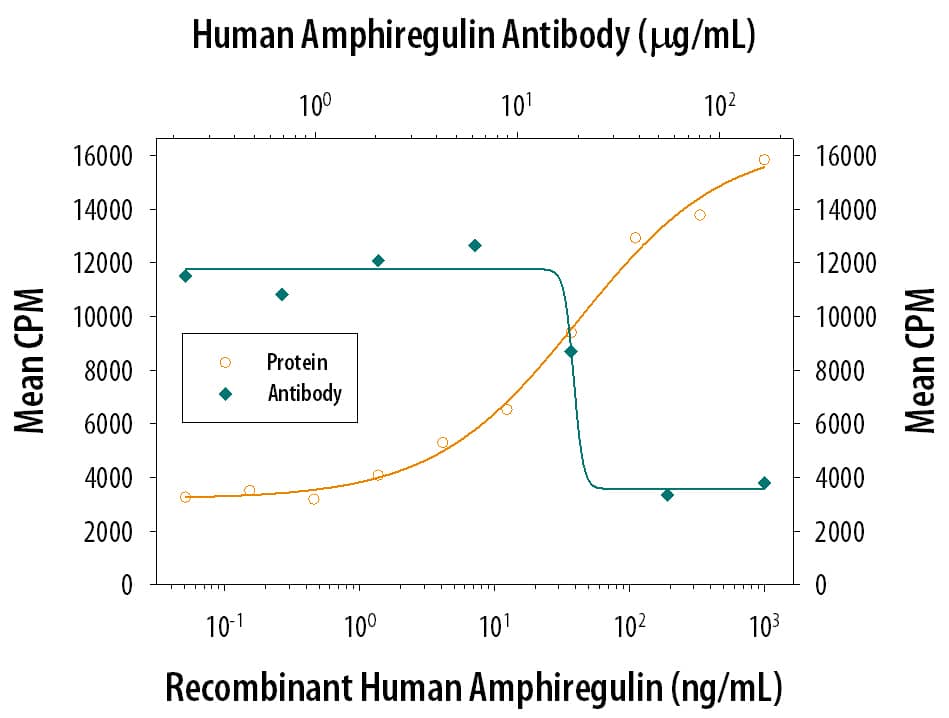Human Amphiregulin Antibody
R&D Systems, part of Bio-Techne | Catalog # AB-262-NA

Key Product Details
Species Reactivity
Validated:
Cited:
Applications
Label
Antibody Source
Product Specifications
Immunogen
Val107-Lys184
Accession # P15514
Specificity
Clonality
Host
Isotype
Endotoxin Level
Scientific Data Images for Human Amphiregulin Antibody
Cell Proliferation Induced by Amphiregulin and Neutralization by Human Amphiregulin Antibody.
Recombinant Human Amphiregulin (Catalog # 262-AR) stimulates proliferation in the Balb/3T3 mouse embryonic fibroblast cell line in a dose-dependent manner (orange line). Proliferation elicited by Recombinant Human Amphiregulin (50 ng/mL) is neutralized (green line) by increasing concentrations of Goat Anti-Human Amphiregulin Polyclonal Antibody (Catalog # AB-262-NA). The ND50 is typically 5-20 µg/mL.Applications for Human Amphiregulin Antibody
Immunohistochemistry
Sample: Immersion fixed paraffin-embedded sections of human breast cancer tissue
Western Blot
Sample: Recombinant Human Amphiregulin (Catalog # 262-AR)
Neutralization
Formulation, Preparation, and Storage
Purification
Reconstitution
Formulation
Shipping
Stability & Storage
- 12 months from date of receipt, -20 to -70 °C as supplied.
- 1 month, 2 to 8 °C under sterile conditions after reconstitution.
- 6 months, -20 to -70 °C under sterile conditions after reconstitution.
Background: Amphiregulin
Amphiregulin (AR) is a member of the EGF family of cytokines which is comprised of at least ten proteins including EGF, TGF-alpha, HB-EGF, and the various heregulins. All of these cytokines are synthesized as transmembrane precursors and are characterized by the presence of one or several EGF structural units in their extracellular domain. The soluble forms of these cytokines are released by proteolytic cleavage. Amphiregulin was originally isolated from the conditioned media of a PMA-treated MCF-7 human breast carcinoma cell line. The AR cDNA encodes a 252 amino acid (aa) residue transmembrane precursor. Multiple forms of native AR containing either 78 or 84 aa residues and both N- and O-linked oligosaccharides have been found. Amphiregulin mRNA expression can be detected in numerous carcinoma cell lines and the epithelial cells of various human tissues including colon, stomach, breast, ovary, kidney, etc.
Human AR stimulates the proliferation of various human and mouse keratinocytes, mammary epithelial cells and some fibroblasts. AR is also a growth inhibitor for various tumor cell lines. In certain colon carcinoma cell lines, AR has been shown to be an autocrine growth factor. Amphiregulin can bind to the EGF receptor. It has been suggested that in certain cell types, AR bioactivity may be mediated through the EGF receptor. The 98 aa residue long form of recombinant amphiregulin has shown to be approximately 5‑10 fold more active than the 78 aa residue form of recombinant AR in an in vitro proliferation assay using Balb/3T3 fibroblasts.
Additional Amphiregulin Products
Product Documents for Human Amphiregulin Antibody
Product Specific Notices for Human Amphiregulin Antibody
For research use only
